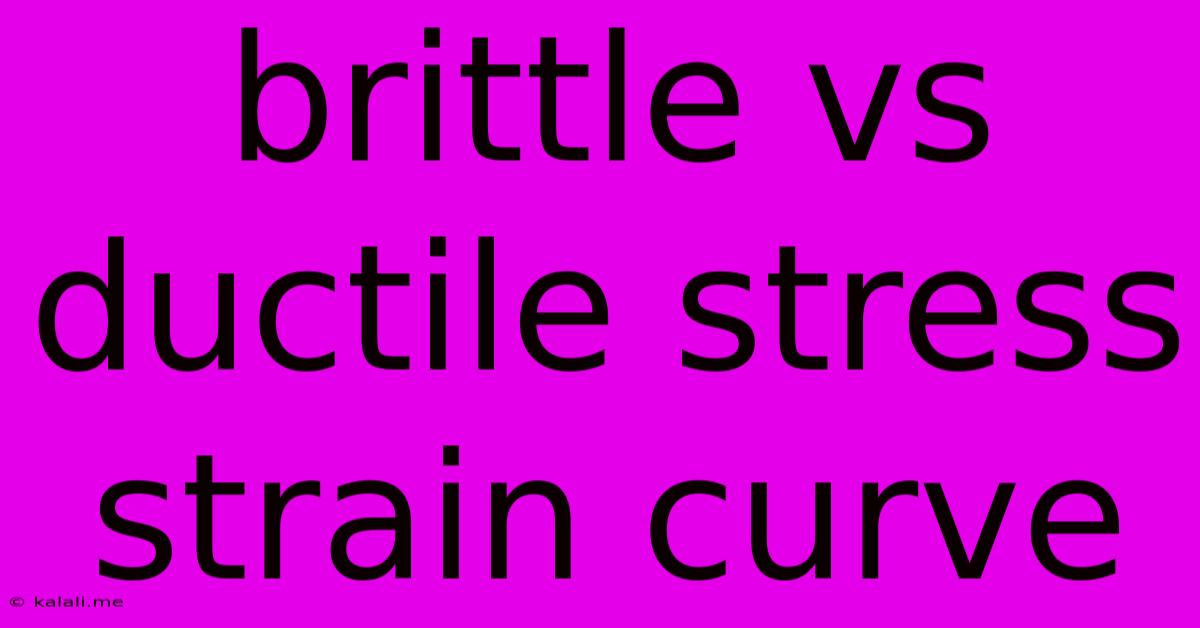Brittle Vs Ductile Stress Strain Curve
Kalali
Jun 14, 2025 · 3 min read

Table of Contents
Brittle vs. Ductile Stress-Strain Curves: A Comprehensive Guide
Understanding the difference between brittle and ductile materials is crucial in engineering and materials science. This difference is clearly illustrated by their respective stress-strain curves, which reveal how a material behaves under increasing tensile load. This article will delve into the characteristics of brittle and ductile stress-strain curves, highlighting key distinctions and providing practical examples.
What are Stress and Strain?
Before diving into the curves, let's briefly define stress and strain. Stress is the force applied per unit area of a material, while strain is the deformation or change in length of the material relative to its original length. The relationship between stress and strain is often represented graphically as a stress-strain curve.
The Ductile Stress-Strain Curve:
Ductile materials, like mild steel or aluminum, exhibit significant plastic deformation before failure. Their stress-strain curves are characterized by several key features:
- Elastic Region: This initial portion of the curve shows a linear relationship between stress and strain. The material deforms elastically, meaning it returns to its original shape once the load is removed. This region is governed by Young's Modulus (E), a measure of the material's stiffness.
- Yield Point: Beyond the elastic region, the material begins to yield. This is often marked by a noticeable deviation from linearity, indicating the onset of plastic deformation. The yield strength (σ<sub>y</sub>) represents the stress at which plastic deformation begins.
- Plastic Region: This region represents permanent deformation. The material continues to deform plastically even after the load is removed. This region shows strain hardening, where increasing stress is required to cause further deformation.
- Ultimate Tensile Strength: This is the maximum stress the material can withstand before necking (localized reduction in cross-sectional area) begins.
- Fracture Point: This is the point where the material finally breaks. The elongation at fracture is usually significant for ductile materials.
The Brittle Stress-Strain Curve:
Brittle materials, such as glass or cast iron, exhibit little to no plastic deformation before failure. Their stress-strain curves are considerably different from those of ductile materials:
- Linear Elastic Region: Similar to ductile materials, brittle materials exhibit an initial linear elastic region, obeying Hooke's Law.
- Fracture: After the elastic limit is exceeded, the material fractures suddenly with minimal or no plastic deformation. There is no clear yield point or plastic region. The fracture occurs at a relatively low strain compared to ductile materials.
Key Differences Summarized:
| Feature | Ductile Material | Brittle Material |
|---|---|---|
| Plastic Deformation | Significant | Minimal to none |
| Yield Point | Clearly defined | Not clearly defined |
| Strain at Fracture | High | Low |
| Fracture Appearance | Cup and cone fracture | Sudden, usually flat fracture |
| Examples | Mild steel, aluminum, copper, many polymers | Glass, cast iron, ceramics, concrete |
Engineering Implications:
The difference between brittle and ductile behavior has significant implications in engineering design. Ductile materials offer the advantage of warning signs before failure (yielding), allowing for some deformation before complete fracture. Brittle materials, on the other hand, fail suddenly without warning, making them less desirable in applications where safety is paramount.
Conclusion:
Understanding the differences between brittle and ductile stress-strain curves is vital for selecting appropriate materials for various engineering applications. By considering the material's behavior under stress, engineers can design safer and more reliable structures and components. The ability to interpret these curves allows for informed decisions, minimizing the risk of catastrophic failures.
Latest Posts
Latest Posts
-
Mosses And Lichens Are Found In
Jun 14, 2025
-
An Organism That Feeds On Dead And Decomposing Matter
Jun 14, 2025
-
Which Of The Following Is A Characteristic Of Shifting Cultivation
Jun 14, 2025
-
Top 10 Freedom Fighters Of India
Jun 14, 2025
-
What Are The Units For Angular Momentum
Jun 14, 2025
Related Post
Thank you for visiting our website which covers about Brittle Vs Ductile Stress Strain Curve . We hope the information provided has been useful to you. Feel free to contact us if you have any questions or need further assistance. See you next time and don't miss to bookmark.